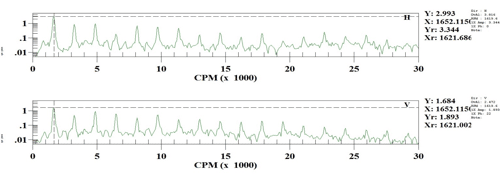VSC ID FAN Vibration Case Study
VSC’ client had an ID Fan that there online monitoring system showed increasing vibration. Unfortunately, their online system was extremely limited and did not offer spectrum analysis, so they asked us to dispatch our personnel to analyze the vibration to determine the problem.

Figure 1: ID Fan Diagram
Figures 2 and 3 are the spectra collected from the inboard and outboard ID fan bearings. Both bearings have peak vibration levels of 3.0 inches per second (ips) at the fan operating speed of 1621 cycles per minute (cpm) in the horizontal direction. In addition, the spectra all show harmonics of the fan operating speed and a raised noise floor, which indicates a very strong sign of bearing wear in the sleeve bearings. Since our customer needed to return to operation, our personnel focused on resolving the balance issue to reduce the vibration.

Figure 2: Outboard ID Fan as VSC found it

Figure 3: Inboard ID Fan bearing vibration as VSC found it
Our staff conducted the balancing and ended up adding a static forty ounces of weight on the ID fan. This weight significantly reduced the vibration at fan operating speed by over 80% from the original 3.0 ips. Unfortunately, there was still an elevated noise floor and harmonics of the fan operating speed, signifying that the bearings were worn. The customer was still able to meet their production schedule which was most important since it was in the middle of a hot summer where they received premium income on the elevated electricity rates. A few weeks later the hot weather subsided and our client was able to make the necessary bearing repairs as well.

Figure 4: Outboard ID Fan after balancing

Figure 5: Inboard ID Fan after balancing
Vibration analysis is the easiest way to quickly and easily identify a deteriorating machinery condition. Once recognized, it is just as easy to track it so you can find the best time in your schedule to make the repairs. The process of maintenance is rapidly changing, so if you are not using vibration analysis to measure your machinery conditions contact us, and we can help you transition to an intelligent maintenance organization.